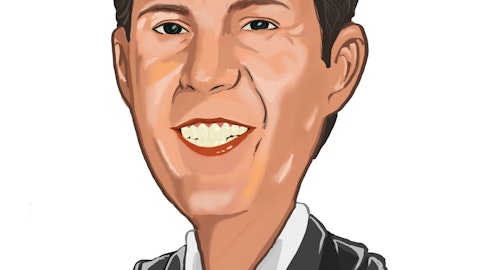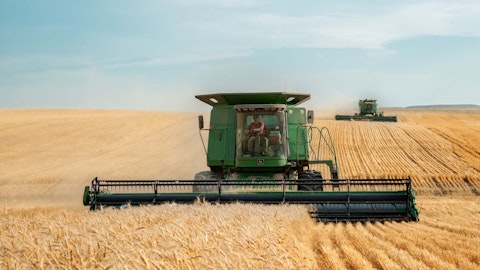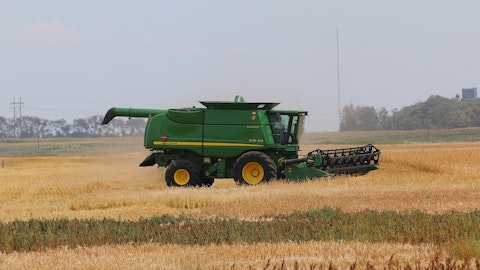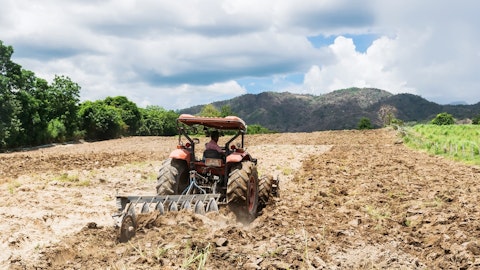Tami Zakaria : Given there were some one-off items this year, taking those out, can you just confirm what kind of core incremental margins you’re expecting in each of your segments in 2023?
Brent Norwood : Yes. Absolutely. Good morning, Tami. We can talk through that. We did have a few special items in the year on the construction side, the onetime gain on the Deere-Hitachi deal as well as some Russia impairment. When we look at incrementals for next year, a couple of things to keep in mind. One, it’s really still a very dynamic operating environment that we’re in. We are still seeing some production costs running higher, right? Labor, energy. A lot of our purchase components are all going to be higher. Some of that is getting offset by decreases in raw materials and freight. But all in all, we could see mid production costs increased by mid-single digits next year. We’re also going to see a little more higher SA&G and R&D in the year as well.
Now we’re getting the price to offset that and enough to put us back in line with historical incrementals at Deere. So I think even once you adjust for some of those onetime items, you’ll see incremental margins sort of commensurate with what we’ve done traditionally or maybe even just a tad higher.
Josh Jepsen: Yes, Tami, it’s Josh. One thing to add there is, I think what’s important too is probably a bit above historically what we’ve done on the incremental side when you take out some of the onetime items. But we’re also investing pretty heavily in executing on this future of where we’re headed. And thinking about the Leap Ambitions and some of the business model transformation that we’re working through that are going to — as we deliver that, create more value for customers, to dampen cyclicality and create a more resilient business. So there’s — embedded in here is investment in strategic projects to deliver on that.
Operator: Our next question comes from Matt Elkott of Cowen.
Matt Elkott: Brent, and I think, John, you mentioned that a little less than 50% of production will come in the first half. Given the fact that you guys have more of a tailwind for pricing in the first half and more of a tailwind from subsiding costs in the second half does ultimately the earnings cadence basically just follow the production cadence for the year?
Brent Norwood : Matt, with respect to the earnings cadence, I think that’s probably a fair assessment that you’ll see. You’ll see earnings cadence, sort of follow that production ramp that you just outlined there and sort of the puts and takes between higher price in the first half of the year, lower production costs in the back half of the year. So I think those sort of net out a little bit. And really, you can just I think, factor in some of those traditional incrementals as you apply them to the varying production rates throughout the course of the year.
Josh Jepsen : Yes, Matt, it’s Josh. Maybe one thing to point out. It’s been a while since we’ve had a year that followed a typical trend for seasonality. And I think this this year, ’23 probably returns a bit more to that, where you see higher levels of both sales and margin in 2Q, 3Q, which is much more traditional to what we’ve done in the past.
John May : Maybe just to add to Brent and Josh’s comments, we’re much — very much focused on getting off to a strong start in 2023 and getting our machines delivered to our customers. really, the bottom line, I think, for you all to take away is, we won’t be as back-end loaded in ’23 as we were in 2022, and we’re doing everything to keep up just the outstanding production progress that you saw in the fourth quarter, and we believe we’ll be able to continue with that execution into the first and second quarter of 2023.
Operator: Our next question comes from Jerry Revich of Goldman Sachs.
Jerry Revich: I’m wondering if you could just talk about Precision Ag. Can you just update us on Blue River we’re talking to folks that are seeing pricing in the mid- to high single digit dollars per acre range for the subscription. I’m wondering if you could comment if that’s representative of the pricing points. And I believe you folks planned on full rate production year two of commercial availability. I’m wondering, is that still the plan for 2024 at this point?
Brent Norwood : Just a couple of high-level comments on Precision, and we can dive in to Autonomy and See & Spray after that. But overall, we’re seeing kind of higher take rates for a lot of our existing technologies that have been in the market for the last couple of years, I would say anywhere from 5% to 10% higher take rates in 2023.So we’re super encouraged by that. Technologies like ExactEmerge and ExactApply continue to do well, continue to penetrate the market further. Also notably, some of the newer technologies that we’ve had, like ExactRate or the CH950 have also made really good inroads as we start filling out the order book for next year. I think for ExactRate, we’re almost double the take rate almost 20% going into next year.
Now as you noted, we’re also very focused on some of these next-gen technologies like See & Spray, like Autonomy. And those two technologies carry with them more recurring revenue opportunity than we’ve had in the past.So we’ve been super encouraged by putting this out with customers. We’ve done it on a limited basis. But these are paying customers, and they are adapting to the new business model, and that’s part of the learnings that we’ve had over the course of the summer. And then in the fall, we were running autonomous paid acres over the fall. The vast majority of our customers have really accepted the model, and we’re really encouraged by that. We’re going to get a little bit smarter and tighten that up as we go into 2023, which will be a second year of a limited production release there.
John May: Yes, Brent, just to add to that, I think an important comment that underscores why this is happening and why we’re seeing these strong take rates is the current environment underscores the need for precision challenges of our customers are definitely more acute than they’ve ever, ever been and the need for our customers to do more with less is greater than it’s been in the past, especially when you consider all the rising input costs, not just labor scarcity, but lack of skilled labor. So precision ag is the best solution to help them solve these very, very difficult problems. We’re more confident today in our opportunity to create value for our customers through our identified $150 billion of IAM, and we’re going to continue to prioritize our investments towards the technologies and solutions that unlock that value.
And Josh indicated earlier on. This year, we’re spending more than we ever have in the past to create those new products, new solutions, and that’s going to have a big benefit in future years.
Josh Jepsen : Great point, John. Maybe one thing I’d add there is we’ve also made a change to our dealer pay for performance. So we’re including precision ag execution in that pay for performance. And that’s a really important step as we think about continuing to drive the outcomes that we wanted to deliver and really a shift from adoption to utilization to make sure we’re delivering on that and we’re showing and demonstrating the incremental addressable unlock that we can create, which we think is differentiated for Deere.
Operator: The next question comes from Nicole DeBlase of Deutsche Bank.





